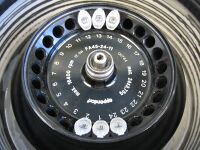Ethanol precipitation of nucleic acids
| back to protocols | ||
Nucleic acid precipitation is used to concentrate and/or purify nucleic acids. The below protocol is based on the fact that nucleic acids are less soluble in alcohol than in more polar water. Addition of salt further decreases solubility by competing for water dipoles; as does low temperature. See Purification of DNA for related protocols.
Material
- 100% ethanol (for analysis)
- 70% ethanol (store @ 4°C)
- 3M sodium acetate pH 5.2 (store @ 4°C)
- 5M ammonium acetate
- -20°C freezer
- Optional: you can use linear polyacrylamide, glycogen or tRNA as precipitation carrier --zurdo 03:45, 9 October 2009 (EDT)
- tabletop centrifuge
Procedure
Eppendorf Protocol


- Add the following to your sample in the order they appear:
- 1/10 volume of 3M sodium acetate, pH 5.2 or 1/2 volume of 5M ammonium acetate
- 2-3 volumes of 100% Ethanol
- Mix and freeze overnight in -20. This step some say is unnecessary but others swear by it. If you are in a rush you can also put it in the -80 for ten minutes to a few hours. Dry ice for 10-15 minutes also works.--Heather
- In general, the time you need to incubate in the freezer depends on how much nucleic acid you have, how big it is and the volume it is in. My general protocol is to freeze for 20 min to 1 hr at -80 ˚C. This seems to work well for most things, but you may want to freeze longer if you have only a small concentration of nucleic acid or if it is small in size(<15 nucleotides).--Kathleen
- If you are in a hurry, you can also dip you epi shortly into liquid nitrogen. If you added enough ethanol, the mix won't freeze. Careful with isopropanol - it freezes more quickly. This works well for me and saves me a lengthy incubation in the fridge. --Jasu
- Spin at full speed in a standard microcentrifuge at 4 degrees for 30 minutes. Make sure to mark the outermost edge of the tube so you can find the pellet easily (or just put the hinge portion of the tube to the outside). It is clear and usually looks like a little smudge on the tube.
- Decant (or carefully pipet off) the supernatant.
- Dry the pellet. For this you can air dry (tubes open, ~15 min) or dry in a speedvac. DNA and RNA (if you don't have RNases in your sample) are typically hearty enough for you to air dry at 37 ˚C, if desired.
- Overdrying can make DNA hard to re-dissolve. Especially for longer DNA, I avoid vacuum drying and airdry only briefly before re-dissolving. --Jasu
- Add your desired quantity of water. Vortex and spin down to resuspend.
- Beware of using water unless you are sure of what you are getting in to. The "pH" of water can vary widely (I've seen from pH 5 to pH 8.5), and depurination of DNA at low pH or degradation of RNA at high pH are possibilities. Water also typically contains trace metals, which can accelerate these reactions. I typically recommend resuspension in TE (10 mM Tris-HCl, pH 7.5, 1 mM EDTA). This makes sure your nucleic acid is at a neutral pH and the EDTA will chelate any trace metals. Since they are in such small amounts, neither the buffer nor the EDTA will affect most downstream reactions.--Kathleen
96 Well Plate Protocol
- Add to each 10 µl product:
- 1.9 µl of Na acetate 3M
- 60 µl of 85% ethanol
- Mix thoroughly (vortex ???) and keep at -20°C for 30 min
- centrifuge for 45 min at 4000 rpm and 4°C (program 3; balance)
- remove supernatant (invert tube on trash once)
- add 150 µl of 70% ethanol and mix
- centrifuge for 15 min at 4000 rpm and 4°C
- remove all supernatant (invert tube on trash)
- invert tube on paper tissue
- centrifuge for 2 min at 500 rpm
- take out the tube and let it dry in the fume hood at room temperature for 10-15 min
- put 20 µl of formide dye using multipipette (nasty chemical to manipulate in fume hood)
- vortex thoroughly/spin/vortex/spin
- transfer the 20 µl (multipipette) in a sequencing plate
- put septum on top, press, tap once (do NOT mix)
- keep on ice in aluminium rack
- Heat 3 min at 95°C (SWATI/95-CST) to keep in single stranded form)
- keep on ice in aluminium rack
Notes
- We tend to wash the DNA with 70% Ethanol after removing the first supernatant (the one containing sodium acetate and 100% Ethanol). Which means add 200-300µl 70% Ethanol to the DNA-pellet. Then spin at full speed for 5mins @ 4°C. Carefully remove supernatant. Proceed with drying. --Janosch
See also
- Purification of DNA - overview of methods
- Ethanol precipitation of small DNA fragments
- Isopropanol Precipitation for PCR Purification - 2-propanol instead of ethanol
BioCoder version
Following is the Ethanol precipitation of nucleic acids protocol in BioCoder, a high-level programming language for expressing biology protocols. What you see here is the auto-generated text ouput of the protocol that was coded up in BioCoder (see Source code). More information about BioCoder can be found on my home page. Feel free to mail me your comments/ suggestions.Vaishnavi
Text Output
Ethanol precipitation of nucleic acids protocol
Source Code
Ethanol precipitation of nucleic acids protocol - source code